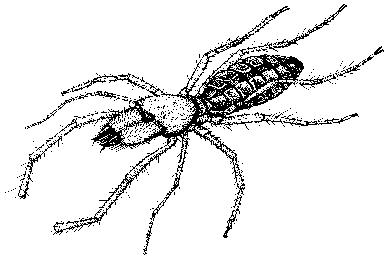 Speedy Solpugids - April 2, 2008 Jeff Schalau, Associate Agent, Agriculture & Natural Resources, Arizona Cooperative Extension, Yavapai County  Solpugids are also called wind scorpions, sun spiders, and camel spiders. They are small but speedy predators. Their body is often covered with short hairs and divided into two distinct body segments - a cephalothorax (head) with two distinct eyes and four pairs of legs and a 10 segmented abdomen. In the western U.S., they vary in size from 15 to 45 mm (5/8 to 1 ¾ inches), are light tan to brown with an often darker abdomen. Solpugids are also called wind scorpions, sun spiders, and camel spiders. They are small but speedy predators. Their body is often covered with short hairs and divided into two distinct body segments - a cephalothorax (head) with two distinct eyes and four pairs of legs and a 10 segmented abdomen. In the western U.S., they vary in size from 15 to 45 mm (5/8 to 1 ¾ inches), are light tan to brown with an often darker abdomen.Solpigids somewhat resemble scorpions without claws or stingers. Instead, they have blunt-ended "arms" called pedipalps in addition to their eight legs. They can run very fast carrying the pedipalps above their body. The pedipalps have sticky ends that allow them to catch and hold their prey and are also used for scooping water to the mouth. They have two pairs of large fangs (chelicerae) that work vertically like pliers and project forward from the mouth. None are known to have venom. The name “wind scorpion” comes from the speed with which they run. These primarily nocturnal hunters usually feed on insects, spiders and other arthropods. Once caught, the prey is crushed by the chelicerae. When feeding, they suck out the prey’s body fluids, and eat some of the fine particles, and discard the larger pieces. The southwestern U.S. is known to have over 50 solpugid species and more than 120 species have been described in North America. Outdoors, these highly effective predators are considered beneficial and may even kill an occasional scorpion or centipede. If they are found indoors, they are either feeding on insects or other prey available within the house. Otherwise, they are probably looking for a way to get outside. Since they are fast, they can be difficult to trap, but they can be caught under a jar or glass and moved outdoors. Pesticides are not recommended to kill solpugids. You may assess the situation and learn that another pest is living indoors and providing solpugids with a steady food source. They can also be accidentally brought indoors with firewood. A solpugid’s access into the home can be greatly reduced by checking caulking and weather stripping around windows and doors as well as sealing areas where utilities (water, electricity, gas, etc.) come into the home. Periodically checking around these areas is a good practice and will limit entry by other nuisance pests such as ants, mice, scorpions, centipedes, and kissing bugs. One time, we got a phone call at the Cooperative Extension office and the caller said "I have two weird looking scorpions in a jar, can I bring them in and have them identified?" We told them “of course, bring them in.” By the time they reached the office, the jar contained only one "scorpion" and a pile of claws, legs, and body parts that used to be the other one. As you can probably surmise, these “scorpions” were really solpugids. Since the start of troubles in Afghanistan and the Iraq war, I have received several e-mail messages from U.S. military troops and their families asking about huge camel spiders (the common name for solpugids in that part of the world). Soldiers reported that the camel spiders were huge and ran directly at them as if they were attacking. In reality, this behavior was likely because the camel spider was seeking the shade created by the soldier. I’ve heard similar stories about centipedes here in Arizona. None of these arthropods likes bright light and will run under your shoe to seek shade and cover. All that being said, it’s true that some solpugid species can be over 125 mm (5 inches) long. For the curious, streaming videos of large Middle Eastern solpugids feeding on lizards and mice are available on the web sites such as YouTube. These streaming videos were likely taken by U.S service men. Warning: I don’t recommend watching these videos unless you have a strong stomach and a diverse vocabulary. The University of Arizona Cooperative Extension has publications and information on gardening and pest control. If you have other gardening questions, call the Master Gardener line in the Cottonwood office at 646-9113 ext. 14 or E-mail us at cottonwoodmg@yahoo.com and be sure to include your address and phone number. Find past Backyard Gardener columns or submit column ideas at the Backyard Gardener web site: http://cals.arizona.edu/yavapai/anr/hort/byg/. |